Continuing in our explorations of wool embroidery threads, today we’ll talk about Array Wool, which is a wool thread (crewel weight) that’s produced here in the US. The wool comes from sheep raised in the western part of the US, and it is processed and dyed in North Carolina.
This thread came to my attention through Zollie, a company that produces basic embroidery kits and counted cross stitch kits using Array Wool.
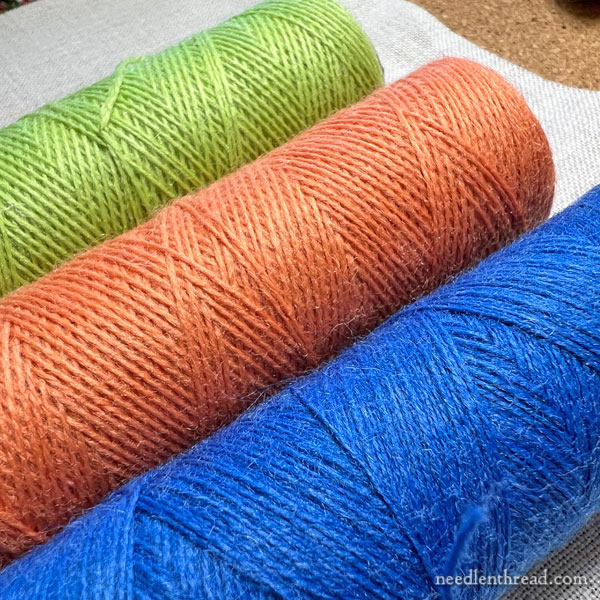
Besides the fact that Array Wool is made in the US, there are other aspects of the wool thread that are somewhat unique.
The most obvious is that the wool is put up on cones and sold that way to the retail market. I’m pretty sure that the reason for this is that Array Wool catered first to the weaving world, where larger cones of thread make a lot of sense.
There’s really nothing problematic about the thread being on cones. After all, in the thread manufacturing process, most hand embroidery thread is put up on larger cones before it ends up in skeins or on smaller spools. And for many people, the sheer quantity of thread on the cone may be considered a good thing.
But for those who stitch smaller projects, or for those who prefer trying a smaller quantity of thread before committing wholeheartedly to a thread that they may be unlikely to get through before arriving in Eternity, the larger put-up on cones may be problematic.
For one thing, the larger quantity comes with a larger price. Considered by the yard, the thread is pretty inexpensive, at about $.06 / yard. But $12.50 to use on a small embroidery project or try out a color is pricy by comparison, if you just don’t need that much thread.
For another thing, larger cones take up more space. Chances are, most hand embroiderers won’t use a whole cone’s-worth of thread on any one project, and this necessitates storage space.
Still, is the cone and quantity a deal breaker for the thread? Not really! If you have the space and you have the budget for it, there are aspects of the thread that may make it worth trying out.
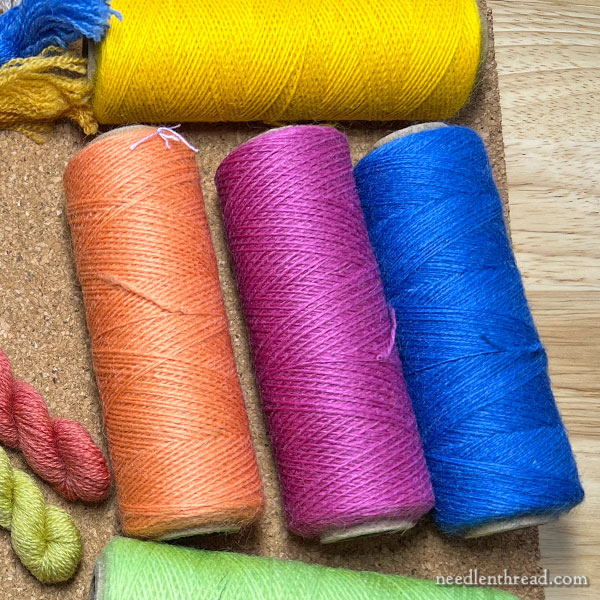
One of those aspects is that Array Wool comes in an array of colors. And some of those colors are quite vivid and contemporary.
Now, I like color! And I like to see wool embroidery threads available in bright colors! So the color aspect is kind of fun.
But let’s get to the nitty-gritty. Let’s talk about stitching…
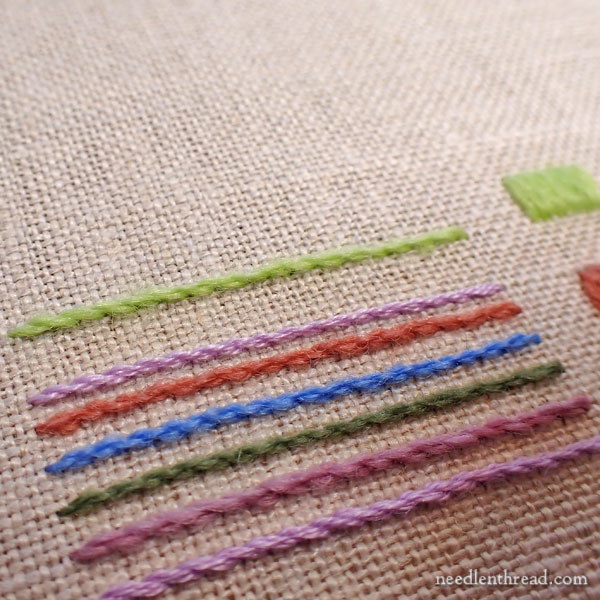
The light green line in the photo above – and the light green block just beyond it – are worked with Array Wool.
You can see that the weight, when stitched, is similar to the other wool threads that we’ve already discussed. (Specifically, you can see the previously-discussed wools in line stitches here and in filling stitches here.)
The stem stitch line worked up easily enough with this wool, although I thought it felt slightly more “rustic” than all the other wools I’ve been stitching with. It just feels a little rougher as it pulls through the fabric. A little scratchier. A little woolier.
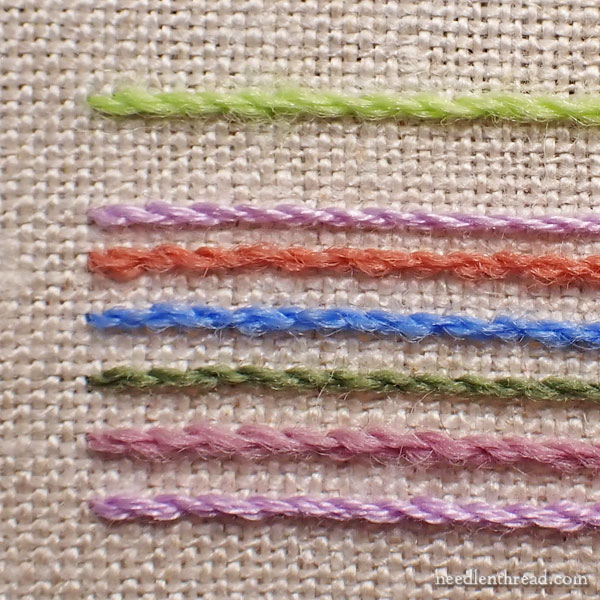
When you look at the lines close up, you can see that the weight of the stitched line is actually slightly heavier than most of the other threads – it’s closest to the Eco Vita (the second thread up from the bottom).
This actually surprised me. On the cone, the thread looks rather thin compared to some of the other crewel embroidery threads. I think this has to do with the tension on the thread when it is spooled onto the cones. Once you start stitching with it, though, it seems to have a normal coverage for this weight of thread.
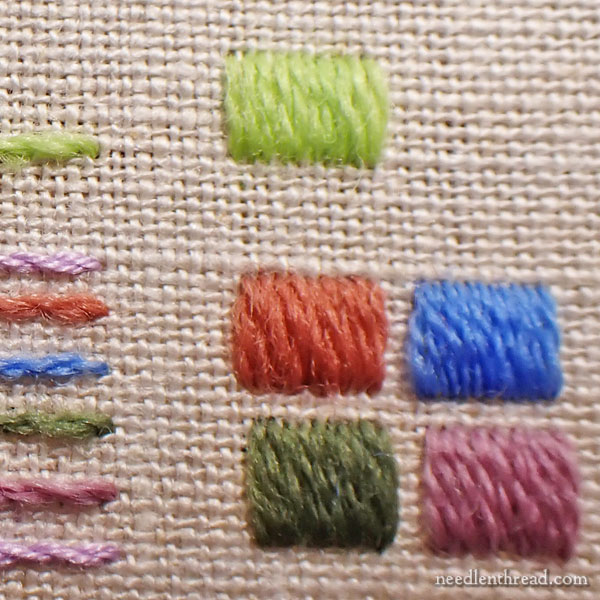
Ditto for the satin stitch – about normal coverage for the satin stitch with this weight of thread.
There is one thing I noticed when I worked the satin stitch, though. Most of the other crewel wools we’ve tried so far have some level of sheen to the wool. It’s not shiny like silk or even like mercerized cotton, but the Heathway, the Fine d’Aubusson, Appleton’s, and the Eco Vita all have at least some noticeable level of sheen to the wool.
The Array wool … not as much. Perhaps there is a hint of sheen to it when stitched, but it is the least sheen-ish of all the wools we’ve played with so far.
This is neither a good nor a bad thing. It really depends on what the user is after, looks-wise.
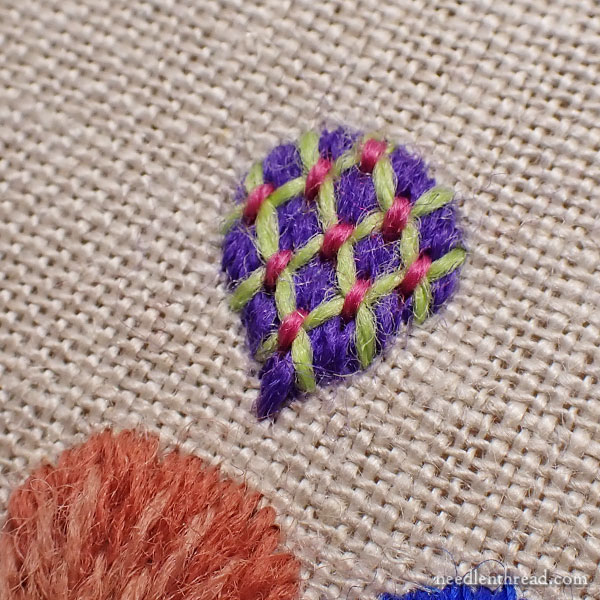
With all the other wool tests, this shape was worked in long and short stitch.
This is where Array Wool fell a bit flat for me. Even though I didn’t have a series of shades of this wool, I still attempted long and short stitch with a couple colors. I tried it a few times.
I found the stitching experience unpleasant. When pulling the wool through the other stitches (splitting up into the previous row of long and short stitch), there was a noticeable and uncomfortable drag on the thread, and I found the thread hesitating trying to knot or pill frequently. The result didn’t look great, and I had to take it out repeatedly.
The thread worked great, though, for satin stitch, for laid stitches (the lattice above the satin stitch) and the little holding or couching stitches on the lattice weren’t that bad to work (although they, too, dragged through the layer of satin stitch).
But for long and short stitch shading, I did not like stitching with this thread.
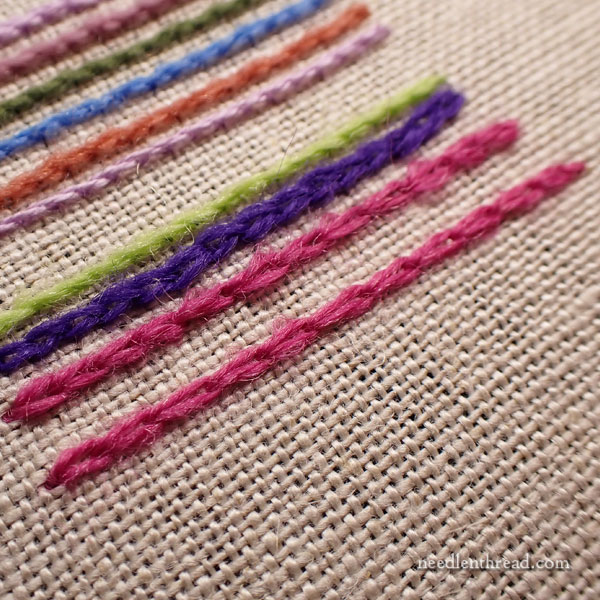
I decided to try chain stitch with this thread. You can see three rows above – the dark purple right after the green, and then two rows of pink.
When working the chain stitch, I take my needle and thread into the same hole I emerged from, to form the loop for the chain. I found this difficult to do with the Array Wool. It’s doable, but it’s got more drag to it than I notice with other wools.
It’s almost as if the fibers from each part of the thread, as they pass by each other. want to grab ahold of each other. Is this a result of the finishing? I don’t know. But I know I don’t like that feeling.
I wonder if the difference I feel in the thread when I stitch with it is the result of working with a thread that is not primarily made for embroidery? As a comparison, I might say it’s kind of like embroidering with yarn made for knitting or crochet. If you try embroidering with typical crochet or knitting yarn, passing in and out through plain weave fabric and through other stitches, you’ll notice that the yarn behaves differently from embroidery thread. Why? because its process, structure, and finishing are not the same.
Does that mean you can’t use this thread for embroidery? Not at all! You just have to be aware that it might feel and behave a little different from the thread you’re used to embroidering with.
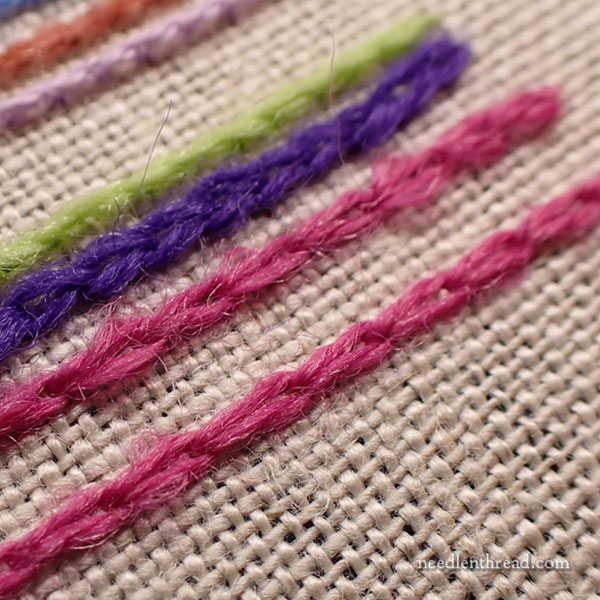
Let’s talk about those two bright pink lines.
Those are both chain stitch, but they are achieved with a tambour hook. You can’t blame me for trying! The thread comes on a spool, after all, which makes it ripe for tambour use.
The first tambour line (top, in the photo above, next to the purple), came out pretty awful. I mean, really awful. I attributed this to two points: 1. I’m tambour stitching with wool (!), and 2. my tambour hook was too small.
I switched to a larger tambour needle for the second line (last line in the photo above). This line came out much better, though I still had some snaggy encounters between the tambour hook and the wool. But still – it was much smoother with the larger hook.
It’s a possibility. I might explore it further. Some day!
I’ve done a little more stitching with the Array Wool, just to get a feel for it. In a nutshell, I’d describe it as a slightly more rustic stitching experience, compared to the other wools. I that a bad thing? Not necessarily. It all depends on what you’re looking for!
We still have more explorations ahead of us, but I wanted to devote an article to Array Wool because many of you had questions about it. I hope I gave you a good idea of what my stitch experience with the wool was like!
Hope you have a terrific weekend!







Your description makes me wonder if this is a woolen-spun yarn? I don’t know anything about wool embroidery, but perhaps the convention is to use worsted wool, and that’s why this wool, in contrast, seems “rustic” to you?